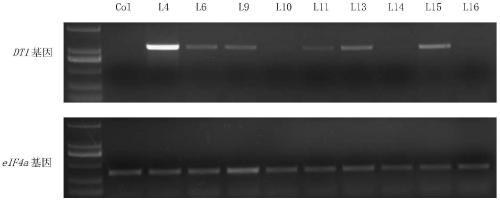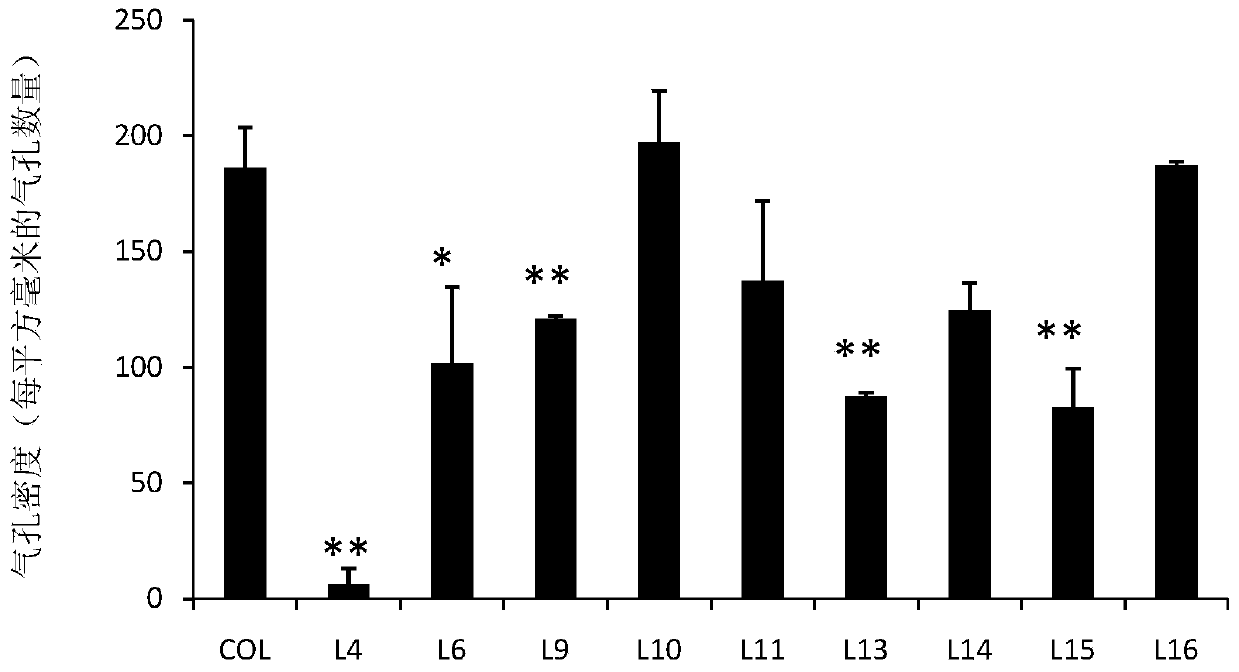Application of dt1 protein in regulation of plant stomatal density and improvement of plant drought resistance
A protein and plant technology, applied in the application field of DT1 protein in regulating plant stomatal density and improving plant drought resistance, can solve problems such as reducing cell turgor, reducing leaf area and photosynthetic source, and limiting cell expansion.
- Summary
- Abstract
- Description
- Claims
- Application Information
AI Technical Summary
Problems solved by technology
Method used
Image
Examples
Embodiment 1
[0057] Example 1. Construction of recombinant plasmid
[0058] 1. Design and synthesis of primers
[0059] F1: 5'-CACCATGATACATTACGAACAAAACA-3';
[0060] R1: 5'-TCACTCGCATTCTCCTTCAGT-3'.
[0061] 1. Extract total RNA from Colombian ecotype Arabidopsis and reverse transcribed into cDNA.
[0062] 2. Using the cDNA obtained in step 1 as a template, a primer pair consisting of F1 and R1 is used for PCR amplification to obtain a PCR amplification product (after sequencing, the PCR amplification product is shown in sequence 2 of the sequence list).
[0063] 3. Take the PCR amplification product obtained in step 2 and use the Gateway cloning entry kit and operate according to the kit instructions to obtain the entry clone (the PCR amplification product is introduced into the pENTR / TEV / D- in the kit vector, get the entry clone).
[0064] 4. Take the entry clone, use the Gateway cloning expression kit and operate according to the kit instructions, insert the DNA molecule shown in sequence 2 betwe...
Embodiment 2
[0065] Example 2. Obtaining of DT1 gene overexpression plants
[0066] 1. Obtaining DT1 gene overexpression plants
[0067] 1. The recombinant plasmid pMDC32-DT1 was introduced into Agrobacterium tumefaciens C58 to obtain recombinant Agrobacterium.
[0068] 2. Take the recombinant Agrobacterium obtained in step 1, and use the inflorescence soaking method to introduce the recombinant plasmid pMDC32-DT1 into Colombian ecotype Arabidopsis thaliana, and harvest the seeds.
[0069] 3. Sow the seeds obtained in step 2 on MS solid medium containing 60 mg / L hygromycin, and select resistant plants (T1 generation plants).
[0070] 4. Extract the genomic DNA of the T1 generation plants and perform PCR identification.
[0071] The primer pairs identified by PCR are as follows (F2 corresponds to the vector backbone, R1 corresponds to the DT1 gene):
[0072] F2: 5'-AAGTTCATTTCATTTGGAGAGGACC-3';
[0073] R1: 5'-TCACTCGCATTCTCCTTCAGT-3'.
[0074] If PCR is identified as positive (PCR amplification yields a...
Embodiment 3
[0080] Example 3. Identification of DT1 gene overexpression plants
[0081] 1. DT1 gene expression level detection
[0082] The seeds to be tested are as follows: L4 strain (30 T3 seeds), L6 strain (30 T3 seeds), L9 strain (30 T3 seeds), L10 strain (30 T3 seeds), L11 Strain (30 T3 seeds), L13 strain (30 T3 seeds), L14 strain (30 T3 seeds), L15 strain (30 T3 seeds), L16 strain (30 T3 seeds) Generation seeds) and Colombian ecotype Arabidopsis (30 seeds).
[0083] The test seeds were sown on MS solid medium and cultured. After 8 days of germination, RNA was extracted and reverse transcribed into cDNA. Using cDNA as a template, PCR amplification was performed using a primer pair composed of F1 and R1 to detect the expression of DT1 gene. . The eIF4a gene is used as the internal reference gene.
[0084] The expression levels of DT1 gene and eIF4a gene are as figure 2 Shown. The results showed that the background expression of DT1 gene in Colombian ecotype Arabidopsis was very low. Co...
PUM
 Login to View More
Login to View More Abstract
Description
Claims
Application Information
 Login to View More
Login to View More - R&D
- Intellectual Property
- Life Sciences
- Materials
- Tech Scout
- Unparalleled Data Quality
- Higher Quality Content
- 60% Fewer Hallucinations
Browse by: Latest US Patents, China's latest patents, Technical Efficacy Thesaurus, Application Domain, Technology Topic, Popular Technical Reports.
© 2025 PatSnap. All rights reserved.Legal|Privacy policy|Modern Slavery Act Transparency Statement|Sitemap|About US| Contact US: help@patsnap.com



